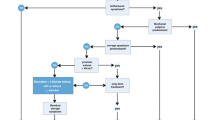Abstract
The storage (irritative) and voiding (obstructive) symptoms associated with benign prostatic hyperplasia are generally attributed to prostate enlargement and increased prostatic smooth muscle tone mediated by the prevailing α1-adrenoceptors in the bladder neck and prostate. This results in obstruction and subsequent secondary changes to the bladder. However, there is growing evidence that many of these symptoms may be due to changes in extraprostatic α1-adrenoceptors, possibly α1D-adrenoceptors. Findings from the VA cooperative trial challenge the current theory that the common side effects associated with these agents are due to vascular action of α1-adrenoceptor blockers.
Similar content being viewed by others
Author information
Authors and Affiliations
Rights and permissions
About this article
Cite this article
Kirby, R., Andersson, K., Lepor, H. et al. α1-Adrenoceptor selectivity and the treatment of benign prostatic hyperplasia and lower urinary tract symptoms. Prostate Cancer Prostatic Dis 3, 76–83 (2000). https://doi.org/10.1038/sj.pcan.4500410
Received:
Revised:
Accepted:
Published:
Issue Date:
DOI: https://doi.org/10.1038/sj.pcan.4500410
- Springer Nature Limited
Keywords
This article is cited by
-
The Diagnosis and Treatment of Lower Urinary Tract Symptoms due to Benign Prostatic Hyperplasia with α-Blockers: Focus on Silodosin
Clinical Drug Investigation (2015)
-
A meta-analysis of efficacy and safety of the new α1A-adrenoceptor-selective antagonist silodosin for treating lower urinary tract symptoms associated with BPH
Prostate Cancer and Prostatic Diseases (2013)
-
The efficacy and safety of silodosin in treating BPH: a systematic review and meta-analysis
International Urology and Nephrology (2012)
-
The effects of dutasteride, tamsulosin, and the combination on storage and voiding in men with benign prostatic hyperplasia and prostatic enlargement: 2-year results from the Combination of Avodart and Tamsulosin study
Prostate Cancer and Prostatic Diseases (2009)
-
Subtypes of α1-adrenoceptors in BPH: future prospects for personalized medicine
Nature Clinical Practice Urology (2009)




